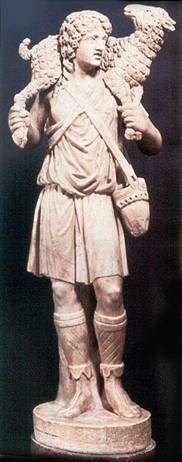Before signing up for this course (on the Catechesis of the Good Shepherd) I knew the name of
Sofia Cavalletti, the Hebrew scholar who, upon being asked to instruct a child in the Christian faith, began by reading to him from Genesis and was delighted to find how eager and curious he was - "the beginner's mind". I hadn't understood before, though, that CGS was a team effort. The Montessori element came from
Gianna Gobbi, who had trained under Maria Montessori herself.
I have seen references to Montessori albums, but had never really understood what that referred to. And herein lies one important difference between Godly Play and Catechesis of the Good Shepherd. In Godly Play we buy scripts written by Jerome W. Berryman, and we stick to them. As I've written before, we're not so slavish as to use notes - not speaking from memory is a sin even greater than deliberately changing the script - bur we are told to use the GP script and live with it before changing wordings. So I asked a very experienced trainer, a big name in the GP community, how long I had to go before I'd be "allowed" to change a phrasing. "You should teach it the way it's written for at least three years first," was the answer.
Now it's true that some of what Berryman has written is beautifully phrased. Some of it is poetry! But not all of it is. [This paragraph could easily grow to another blog post! Let me turn instead to CGS.]
 |
| materials for teaching the Liturgical Colours |
It turns out that an album page is the chatechist's (or directress's or guide's) notes for a lesson or presentation. One doesn't buy it or get given it; one writes this out for oneself. We did one in class today, for the Altar I presentation. For this first one we were more or less told just what to write down, but now that we've learned how to do so our homework tonight is to write out, ourselves, an album page for the presentation of the Liturgical Colors.
Crucially, our notes on the Presentation itself are not to be a "monologue", but an outline of the "key moments" of the presentation, with jotted phrases and/or main ideas. And these notes on the Presentation itself are only one section of many on the album page. We also note ourselves what the aims, both direct and indirect, of the work are. We write down the approximate age of child the presentation is for, the liturgical season it relates to, if any, and even the core doctrinal content of the lesson.
Some of this looks a lot like the material Berryman includes in his books, but I do think today that there's a real value in writing those words out myself rather than merely reading (or, let's be honest, sometimes skimming) them.
 |
| materials: four miniature chasubles |






I knew that there were album pages, but I didn't know that the Catechist wrote them him/herself. Interesting. No wonder CoGS requires so many other hours of training!
ReplyDeleteI also was unaware that Cavaletti had a collaborator. I wonder Gianna Gobbi's name is rarely mentioned?
Glad you are able to give us a play-by-play account!